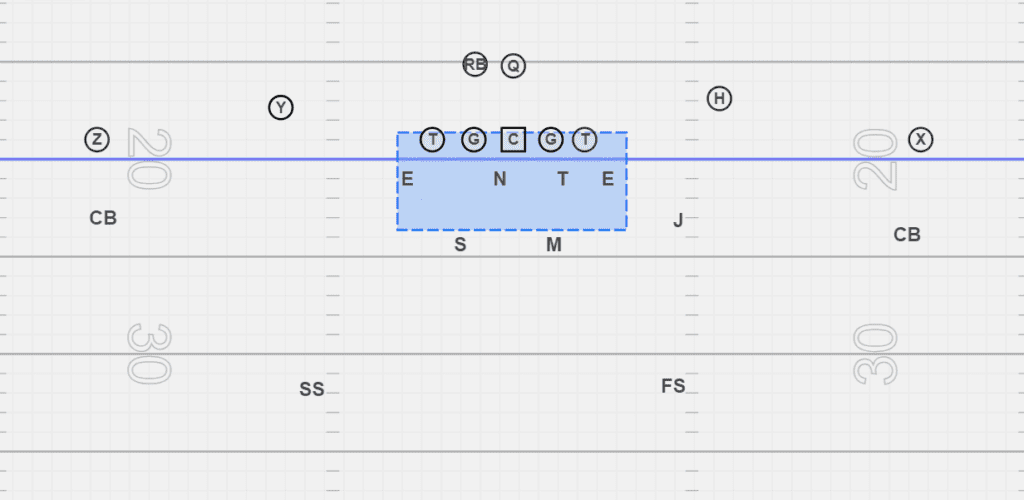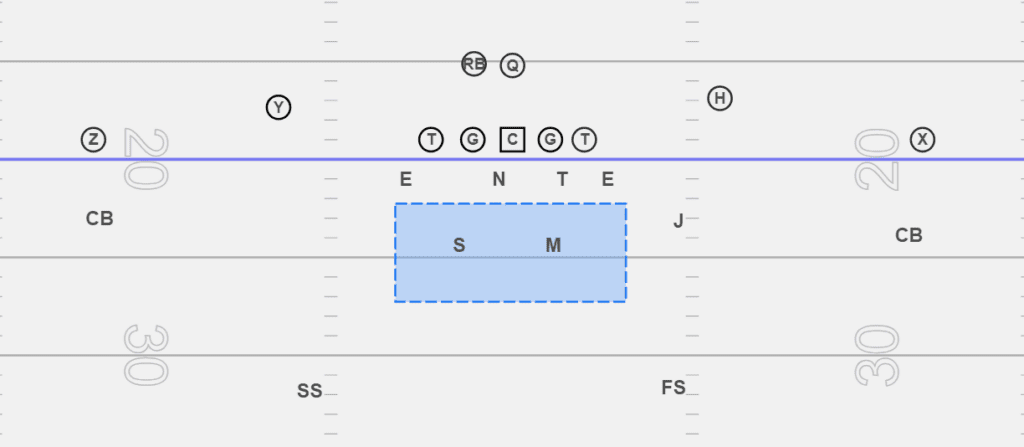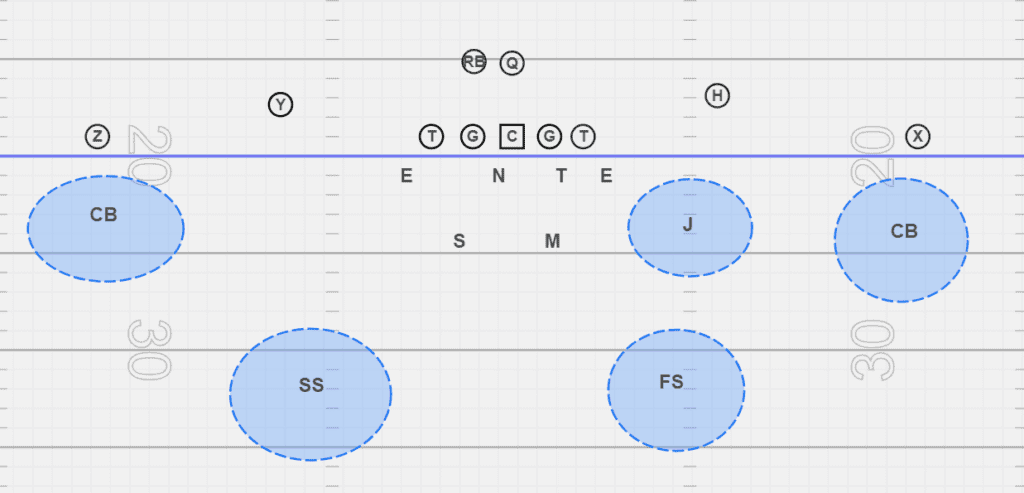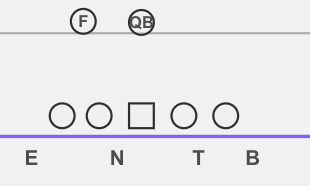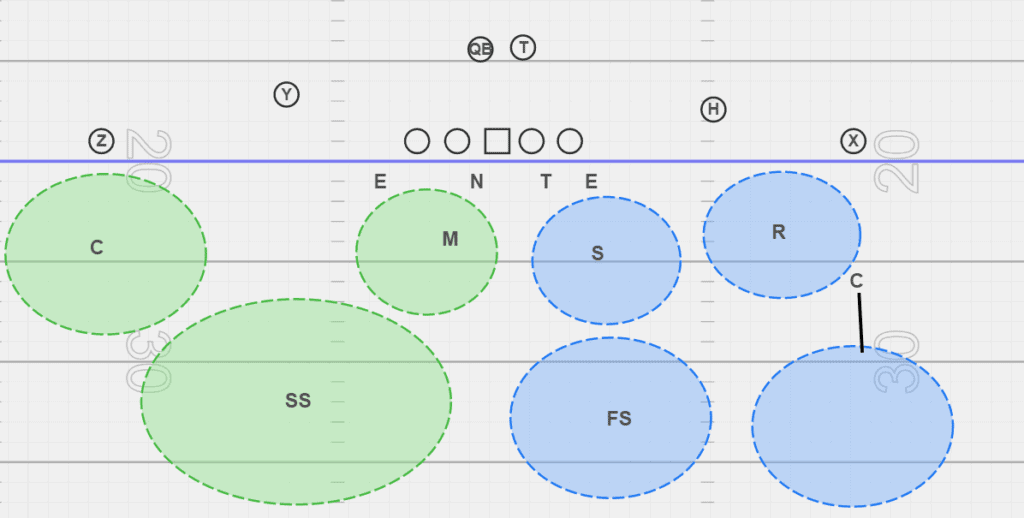This is one of the more popular defenses used by defensive coordinators over the last ten years to stop the spread offense. But what is the 4-2-5 defense and why is it so popular?
The 4-2-5 defense is a defense that has four defensive linemen, two linebackers, and five defensive backs. This defensive scheme is designed to be balanced to stop the run and pass.
In this article, we’ll show you how to properly install the 4-2-5 and everything you need to know to run a successful defense.
4-2-5 Defense
This scheme allows defensive coordinators to be balanced in stopping the run while also having enough defensive backs on the field to cover the pass.
The scheme is unique because it puts more players on the field and uses fewer players to cover the boundary.
The term field refers to the part of the field with more space. The boundary is the side of the field that has less space. Due to the uneven landscape of a football field, one side will always have more yardage than the other side.
Positions
As it states in its name, there are four defensive linemen, two linebackers, and five defensive backs.
These players are important to the defensive alignment and overall structure of the defense.
Defensive Linemen
These players are the ones that attack the offensive line. They must be quick and strong, decide what to do, and fit in with their linemen for a good push.
The defensive lineman should have a great first step and use their hands well. The defensive lineman is often separated by two defensive ends and two defensive tackles.
It’s important the defensive linemen control the offensive line, mainly the offensive tackles in this defense. Teams need to be able to contain on pass plays but also spill the football on run plays.
The four positions on the defensive line are nose tackle, defensive tackle, and the two defensive ends. Their job is to put pressure on the offensive line, quarterback, and tight ends.
Linebackers
The linebackers play a major role in the 4-2-5 defense. They are often box players, meaning their main goal is to stop the run and think about the pass second.
Having five defensive backs on the field protects the linebackers in the passing game, as they will need to cover underneath receivers primarily and don’t need to travel too far.
The linebackers in the 4-2-5 defense will protect the A & B gaps when the defensive front is over/under front. These players are often named the Sam linebacker and Mike linebacker.
The combination of the defensive line and the linebackers allows the defense to cover all six gaps and prevent the offense from running the ball effectively.
Defensive Backs
The 4-2-5 is unique because it utilizes the speed of 5 defensive backs. Teams typically only have five defensive backs on the field when they go to their nickel package.
The 4-2-5 uses a 5th defensive back on the field at all times to maintain the defense’s speed for all four downs.
The jack (or dollar) backer is a hybrid between a linebacker and a defensive back. Their job is to play underneath coverage and be physical enough to play in the run game.
The two safety positions (often called strong safety and free safety) are more involved in the run game than any other defense.
Not only do they have the responsibility to cover the pass, but coaches will use the safeties to make tackles at the line of scrimmage once the linebackers and defensive backs plug their gaps, forcing the ball to spill.
Two cornerbacks will play typically as cornerbacks do in other defensive schemes. This is the one position that doesn’t change much throughout defensive schemes.
How To Install The 4-2-5 Defense
In this section, we will show you how you can install the 4-2-5 defense and the defensive philosophy behind it. We will break down each position and give you ideas on installing it for your team best.
Football coaches will use the 4-2-5 in order to confuse the offensive coordinator to think it’s always going to be a two high structure, whether that be Cover 2 or Cover 4. From this look, they can rotate to a Cover 3 or Cover 1 and still be able to fit the run.
Starting with the defensive line, you need first to determine the names of the defensive linemen. Many coaches will have a tackle and a nose for the interior lineman.
The two defensive ends can be called whatever the coach wants. If the coach decides not to have a strong and weakside defensive end, then he can keep his defensive ends static.
When installing the 4-2-5, it’s important to have front names for where you want your players to align. We recommend reading this article on defensive techniques and alignments to create a baseline for your players.
The two fronts that we will cover in this article are the over and under fronts. These are the two most common fronts that 4-2-5 teams will run to stop the run.
Over Front
The over front can be classified in a few different ways against spread offenses. First, the 3-technique will go to the tight end side if there is a tight end. Teams will use a 1 technique over the center or a 2i over the guard on the backside. This is completely up to the coach.
The 3 techniques can also line up on the same side of the running back or with more receivers if there is no tight end in the formation.
The 3 technique is responsible for controlling the B gap. The 1 technique (or 2i) controls the A gap.
The two defensive ends will line up in 5 techniques outside of the offensive tackle. Both of these players are responsible for covering the C gaps.
Under Front
The 3 technique will go away from the tight end or the back in the under front. This means the 1 technique will go to the side of the tight end or the back.
This is the only differentiator for the defensive front, as the defensive ends will stay in their 5-techniques and maintain control of the C gaps. Each front must be signaled in or verbalized in each play.
Coverages In The 4-2-5 Defense
The fact that there are five defensive backs on the field means that the defense must play split-field coverage. This means that one side of the field will play one coverage while the other will play a completely different coverage.
On one side of the field, teams will often play quarters coverage.
The rules for cover 4 in the 4-2-5 are:
- The corner will have deep 1/4
- The safety will have deep 1/4
- The jack will cover the flats
- The mike linebacker will help in the middle of the field
On the other side of the field, teams will often play some cover 2. Remember, the jack will go to the field, so cover 2 will be played on the short side of the field.
The rules for cover 2 in the 4-2-5 are:
- The cornerback will have the flats
- The safety will have deep 1/2
- The linebacker will support in the hook/curl zone.
Note the difference between regular cover 2 and Tampa 2.
Coaches can use spot drop techniques or man-matching techniques, which we further explain here:
Regardless of what you play, every play must communicate to the players on his side of the field what exactly they’re running.
If you have an advanced group of players, you can rotate your safeties to get into a cover 3 or cover 1 structure.
Keep Learning
The opposing offense needs to get creative in how they are going to attack this base defense. It has a balanced pass rush and pass coverage.
If you liked learning about the 4-2-5 defense, we recommend you check out our Ultimate Football Guide. It will help to greatly increase your football IQ.
Learn more about defensive schemes below.
The Different Looks of the 4-3 Defense
What Is The 3-4 Defense In Football?
The 4-2-5 defense is designed to stop the run but gives the offense many different looks when they come out of the huddle. It’s a defense that can be adjusted and tweaked depending on what your coaches want to do.
The 4-2-5 defense is inherently different from any other defensive scheme, as it can run different coverages on either side of the field. It’s important to create a system of communication (front, coverage) so that each player can get lined up properly.
Let’s keep learning! Our learning center is packed with information regarding techniques, schemes, and more!
If you’re looking for more in-depth breakdowns & coaching resources, visit our coaching resource page here.
If you have any questions on the 4-2-5 tweet, us @vIQtorySports on Twitter. We’d love to answer any questions you may have.

